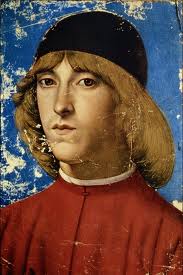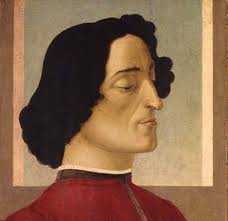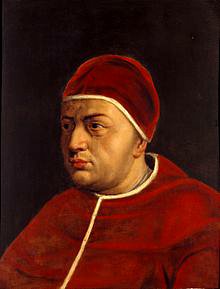Florence and the influence of the de' Medici family during the Renaissance
Florence during the Renaissance had become a financial and cultural center for the Arts and Humanities. It was also an anthill of controversy and deceit that reads like a soap opera between Popes, Kings, Emperors, Political Factions and Rival Families.
The two parties, the Guelfs (pro-pontificat) and the Ghibellines (siding with the holy roman emperors) that governed in the city-states of central and northern Italy were constantly at odds over territory. The names originate from two rival germanic families, the House of Welf (or Guelf) and the house of Hohenstaufen that ruled the Holy Roman Empire from 1138 to 1208 and from 1212 to 1254. When Frederick of the Hohenstaufen family tried to expand his authority into northern Italy, his supporters were called the Ghibellini (the Italian version of the German name). Alarmed, most of the important northern Italian cities united under the auspices of the Lombard League to stand united against the German emperors, and were called the Guelfi.
The citizens had no special affiliate to either of the two and the conflict should have ended with the Council of Worms in 1122 but it continued well into the 15th century, in particular in Florence where power went back and forth for a century. Generally speaking the Ghibellines were landowners and nobility while the Guelfs came from mercantile families. The Guelfs' relationship with the popes was purely political, a co-conspiracy to keep the Ghibellines from gaining power. The popes saw the uncooperative emperors as constant threat to the papal territories and welcomed the financial support.
For the Florentines it was more than just politics; it was a blood-feud, and the city was in the crossfire with gang violence on the streets, murder and kidnapping. They believed the origin stemmed from an incident that took place in 1215 when a young man, Buondelmonte dei' Buondelmonte, refused to marry a girl from a rival family, the Amidei. It was a marriage of convenience, Buondelmonte was in love with a girl from the Donati family. Despite his refusal the preparations for the ceremony went on anyway. The day of the wedding Buondelmonte passed the church where they were waiting for him on his way to see the Donati girl. The public humiliation was too much for the Amidei, and they killed the young man as he crossed a bridge in Florence.
At this point the citizens took sides; the Buondelmonte family was backed by the Guelfs and the Amidei family by the Ghibellines. In 1289 the Guelfs, supported by the rising merchant and working classes, overpowered the Ghibellines but, once in control, the Guelfs had differences of opinion as to the direction of the party, resulting in a schism.
A group called White Guelfs wanted to disassociate from the popes as well as the emperors meddling in their affaires. The second group wanted to remain in the popes' good graces, called Black Guelfs. The de' Medici family, which made its vast wealth through trade (and later with their banks) came from a long line of Guelf affiliates. The split between Guelfs was a distraction to many but inevitable. Dante Alighieri's family was also Guelf and he was among the politically active supporters of the Whites. He was exiled after the Blacks took control of Florence in 1302, pillaging the city and killing a great number of Whites (maybe 600).
Ardingo de’ Medici had been elected "gonfaloniere" in 1296 - like a prime minister with heritage rights - and after his death his son Salvestro de’ Medici replaced him. Salvestro had no allegiance to either party and declared himself a "patrician". In an attempt to control the financial core of the city he courted the rising middle and working class (that appeared after the Plague) against the Guelf nobility, who were in cahoots with the more powerful guilds (unions) to the detriment of the smaller guilds and workers that were not in the system.
One of the largest industries in Florence was wool. In 1345 the wool carders, or "ciompi", had gone on a strike that was short-lived. They tried again in 1378 and succeeded in taking control of Florence (Revolt of the Ciompi). The Ciompi ruled democratically; Salvestro helped them eliminate unfair taxation and put restrictions on the Guelf’s powers but their government was short-lived, the Guelfs regrouped and ousted the Ciompi in 1382. Salvestro was exiled by the Albizzi family, nemesis of the de' Medici.
Salvestro’s cousin Giovanni di Bicci de' Medici was the son of Averardo who started the family dynasty with the first bank in Florence. Giovanni served a term as gonfaloniere but was not into politics. His interest was the family business, which he diversified. His focus was expanding the de' Medici bank.
Giovanni di Bicci’s son Cosimo de’ Medici was captured, imprisoned and exiled from the city by members of the Strozzi and Albizzi families. Instead of direct retaliation Giovanni found clever ways to gain control of Florence without holding public office. He took his bank with him to Padua and Venice and urged other bankers to follow, until the financial loss for Florence was so great he was allowed back in 1434. Though Cosimo stayed out of direct politics he was a remarkable statesman and his influence was tremendous along with the Pitti and Soderini families. To stop the continuous attacks from other city-states he was responsible for crafting a just balance of power between Florence, Naples, Venice and Milan, while dissuading outsiders from invading Italy. Well educated, Cosimo was a patron of artists such as Donatello and Fra Angelico. He financed the Humanists’ cause to revive the classics and opened a cultural dialogue with the Byzantine Empire in the East. He had two sons: Giovanni and Piero (the Gouty, or The Unfortunate).
Giovanni di Cosimo de’ Medici, was gonfaloniere in 1421. Piero di Cosimo de’ Medici had gout. He was in power five years where he was often bedridden and drowned in 1503. He had two sons, Lorenzo and Giuliano (click on "The Americas").
The name Firenze is a derivative of "Fluentia" (Flowing) most likely for its location between the merging Arno and Mugnone rivers. It eventually evolved into "Florentia". There are conflicting reports whether Lucius Sulla gave this fertile land to his veterans in 80 BC, or Julius Caesar 56 BC.
During the early Middle Ages both Byzantines and Ostrogoths fought for control of the territory and it went back and forth in this way until the 6th century, when it was taken from both of them by the Lombards.
Charlemagne occupied the city and its surrounding territories at the end of the 8th century, and around the 11th century it was controlled by nobles.
de' Medici Popes
< Pope Leo X (1475) - Pope Clement VII (1478) - Pope Pius IV (1499) - Pope Leo XI (1535)


Lorenzo de' Medici
Giuliano de' Medici
